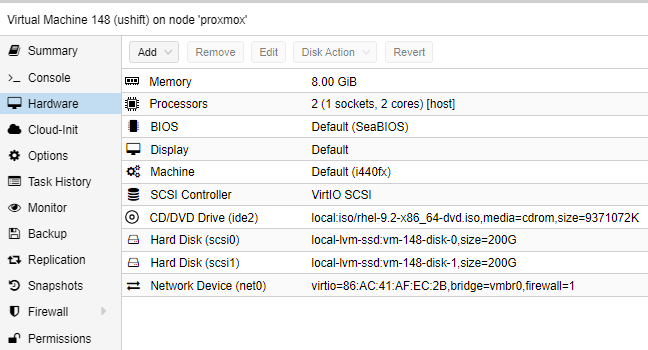MicroShift enables dynamic storage provisioning with the Logical Volume Manager Storage (LVMS) provider. The LVMS plugin is a Container Storage Interface (CSI) plugin for managing LVM volumes for Kubernetes. LVMS provisions new logical volume management (LVM) and logical volumes (LVs) for container workloads with persistent volume claims (PVC). Each PVC references a storage class that represents an LVM Volume Group (VG) on the host node.
Prerequisites
- MicroShift 4.13 installed on RHEL 9.2. Please refer Microshift 4.13 installation on RedHat Enterprise Linux 9.2 for further details.
Configuration
Add an extra hard disk for dynamic storage provisioning using LVMS. Below is a screen shot of my machine configuration. MicroShift is using second hard disk (scsi1) for LVMS plugin.

Create a volume group
Check the physical volumes in the machine by running the following command.
pvsTerminal output for reference
[root@localhost hyrule]# pvs
PV VG Fmt Attr PSize PFree
/dev/sda2 rhel lvm2 a-- <199.00g 0Create a PV. Change physical volume name accordingly by inspecting /dev folder in the system. In my case its /dev/sdb.
pvcreate /dev/sdbTerminal output for reference
[root@localhost hyrule]# pvcreate /dev/sdb
Physical volume "/dev/sdb" successfully created.
[root@localhost hyrule]# pvs
PV VG Fmt Attr PSize PFree
/dev/sda2 rhel lvm2 a-- <199.00g 0
/dev/sdb lvm2 --- 200.00g 200.00gCreate a new volume group
vgcreate hyrule/dev/sdb Terminal output for reference
[root@localhost hyrule]# vgcreate hyrule/dev/sdb
Volume group "hyrule" successfully createdCheck the pvs in the machine.
[root@localhost hyrule]# pvs
PV VG Fmt Attr PSize PFree
/dev/sda2 rhel lvm2 a-- <199.00g 0
/dev/sdb hyrule lvm2 a-- <200.00g <200.00gLVMS Configuration
Create an LVMS configuration file. When MicroShift runs, it uses LVMS configuration from /etc/microshift/lvmd.yaml. Make sure that volume-group ‘hyrule’ is created.
sudo cp /etc/microshift/lvmd.yaml.default /etc/microshift/lvmd.yamlEdit /etc/microshift/lvmd.yaml.
# Unix domain socket endpoint of gRPC
socket-name: /run/lvmd/lvmd.socket
device-classes:
# The name of a device-class
- name: default
# The group where this device-class creates the logical volumes
volume-group: hyrule
# Storage capacity in GiB to be spared
spare-gb: 0
# A flag to indicate that this device-class is used by default
default: true
# The number of stripes in the logical volume
#stripe: ""
# The amount of data that is written to one device before moving to the next device
#stripe-size: ""
# Extra arguments to pass to lvcreate, e.g. ["--type=raid1"]
#lvcreate-options:
#- ""Restart MicroShift
sudo systemctl start microshiftTesting
Create a namespace
oc create ns testCreate test.yaml and copy below contents.
kind: PersistentVolumeClaim
apiVersion: v1
metadata:
name: my-lv-pvc
namespace: test
spec:
accessModes:
- ReadWriteOnce
resources:
requests:
storage: 1G
---
apiVersion: v1
kind: Pod
metadata:
name: my-pod
namespace: test
spec:
containers:
- name: nginx
image: quay.io/jitesoft/nginx
command: ["/bin/sleep", "1d"]
volumeMounts:
- mountPath: /mnt
name: my-volume
securityContext:
allowPrivilegeEscalation: false
capabilities:
drop:
- ALL
runAsNonRoot: true
seccompProfile:
type: RuntimeDefault
volumes:
- name: my-volume
persistentVolumeClaim:
claimName: my-lv-pvcCreate pvc and pod
oc create -f test.yamlCheck the status of pod, pvc and pv.
[hyrule@localhost test]$ oc get po -n test
NAME READY STATUS RESTARTS AGE
my-pod 1/1 Running 0 2m7s
[hyrule@localhost test]$ oc get pvc -n test
NAME STATUS VOLUME CAPACITY ACCESS MODES STORAGECLASS AGE
my-lv-pvc Bound pvc-1d6e6430-b052-4c4b-8ff2-df3b23dd9160 1Gi RWO topolvm-provisioner 2m13s
[hyrule@localhost test]$ oc get pv -n test
NAME CAPACITY ACCESS MODES RECLAIM POLICY STATUS CLAIM STORAGECLASS REASON AGE
pvc-1d6e6430-b052-4c4b-8ff2-df3b23dd9160 1Gi RWO Delete Bound test/my-lv-pvc topolvm-provisioner 2m19s